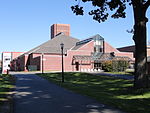Warren McGuirk Alumni Stadium
Warren McGuirk Alumni Stadium is a 17,000-seat multi-purpose stadium in Hadley, Massachusetts, on the campus of the University of Massachusetts Amherst. It has been the Massachusetts Minutemen football team's home stadium since 1965, with the exception of 2012 and 2013, when the team played at Gillette Stadium in Foxborough. From 2014 to 2018, the Minutemen split their home dates between McGuirk and Gillette. Originally known as Alumni Stadium, the facility was renamed in 1984 to honor Warren McGuirk, who was the UMass athletic director from 1948 to 1971. Although it is on the university's campus, which is almost entirely in Amherst, the stadium itself lies just across the town line in Hadley.
Excerpt from the Wikipedia article Warren McGuirk Alumni Stadium (License: CC BY-SA 3.0, Authors).Warren McGuirk Alumni Stadium
Amherst UMass Extension,
Geographical coordinates (GPS) Address Nearby Places Show on map
Geographical coordinates (GPS)
| Latitude | Longitude |
|---|---|
| N 42.377305555556 ° | E -72.536019444444 ° |
Address
McGuirk Alumni Stadium
Amherst UMass Extension
01003
Massachusetts, United States
Open on Google Maps









